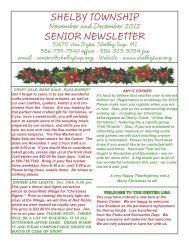RIVER BENDS PARK-WEST AND HOLLAND ... - Shelby Township
RIVER BENDS PARK-WEST AND HOLLAND ... - Shelby Township
RIVER BENDS PARK-WEST AND HOLLAND ... - Shelby Township
Create successful ePaper yourself
Turn your PDF publications into a flip-book with our unique Google optimized e-Paper software.
EXISTING CONDITIONS FOR 'ST<strong>AND</strong> 1. SOUTHEAST FLOODPLAIN'<br />
Land area: 75.34 Acres<br />
Land use history: This floodplain forest may have been here as forest for 100 years or more, as some of the<br />
larger trees are in that age range. There is evidence of a small community or camp at the end of an<br />
abandoned road on the north side of the river, and remains of a business or other old human activity at the<br />
end of a short road south of the river.<br />
Forest Type:<br />
-Existing: Southern Hardwood Floodplain Forest<br />
-Potential: Same<br />
Successional trend: Pole-size to large sawlog-size eastern cottonwoods and silver maples dominate this<br />
extensive and variable river floodplain stand. Also numerous among sawlog-size trees are black willow,<br />
black maple, American sycamore, sugar maple and American basswood. Other trees present in the canopy<br />
are black walnut, boxelder, American elm, bitternut hickory, red maple, northern red oak, swamp white oak,<br />
white oak, bur oak and green ash. The understory includes ash, buckthorn, bur oak, boxelder, silver, black,<br />
red and sugar maples, elm, non-native honeysuckles, sycamore, hawthorn and basswood. Ground vegetation<br />
and vines includes poison ivy, wild grape, Virginia creeper, black swallowwort, multiflora rose, barberry,<br />
various goldenrods, reed canary grass, common St. John's-wort, jewelweed, stinging nettle, garlic mustard,<br />
various thistles, moneywort, enchanter's nightshade, dames rocket, ostrich fern, dandelion, wild strawberries,<br />
meadow horsetail, white avens, wood sorrel, jack-in-the-pulpit, white grass, spotted Joe-Pye-weed, small<br />
forget-me-not, iris, violet, agrimony, early meadow-rue, currant, wild parsnip, bedstraw, sedges, wild<br />
geranium, wild leek, green dragon and giant ragweed.<br />
Forest health: There were no obvious signs of disease, insect infestation or malnutrition among the trees and<br />
shrubs in this stand. The ash trees are dead or dying from emerald ash borer infestation.<br />
Site quality: Site index is estimated at 66 for Silver maple. This stand appears to be a moderate site for<br />
growing silver maples and cottonwoods, and in some areas of higher ground it supports good quality sugar<br />
maple and black walnut. A site index of 66 for silver maple is in the low to moderate range.<br />
Approximate age: 93 Size Class: Medium Sawlogs (17.5 - 23.5")<br />
Trees per acre: 178 Mean Stand Diameter: 16 in.<br />
Basal Area (BA): 69 Acceptable BA: 90 or more<br />
Growth Rate: % Timber Quality: medium<br />
Stocking: Total basal area of 69 square feet per acre is toward the low end of the fully stocked range for this<br />
forest type, equivalent to just over 50% stocked, or 50% of the average maximum stocking expected in<br />
undisturbed stands of similar size and species composition. This relative density is in the optimum range for<br />
best individual tree growth, with excellent growth rate of the largest trees, good growth of medium to<br />
smaller trees, and low mortality from crowding.<br />
Cottonwood and silver maple together comprise nearly 40% of the total basal area, and black willow, black<br />
maple, sycamore, sugar maple and basswood account for another 44% of the basal area. Three oak species<br />
make up only 3 percent of the basal area. Basal area is a method used by foresters to approximate density<br />
14



